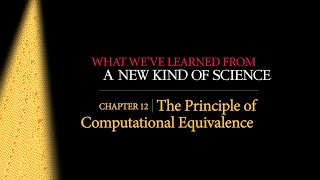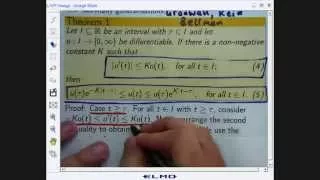
Alina Ostafe: Dynamical irreducibility of polynomials modulo primes
Abstract: In this talk we look at polynomials having the property that all compositional iterates are irreducible, which we call dynamical irreducible. After surveying some previous results (mostly over finite fields), we will concentrate on the question of the dynamical irreducibility of
From playlist Number Theory Down Under 9

In this video I discuss irreducible polynomials and tests for irreducibility. Note that this video is intended for students in abstract algebra and is not appropriate for high-school or early college level algebra courses.
From playlist Abstract Algebra

Irreducibility (Eisenstein's Irreducibility Criterion)
Given a polynomial with integer coefficients, we can determine whether it's irreducible over the rationals using Eisenstein's Irreducibility Criterion. Unlike some our other technique, this works for polynomials of high degree! The tradeoff is that it works over the rationals, but need not
From playlist Modern Algebra - Chapter 11

Irreducibility and the Schoenemann-Eisenstein criterion | Famous Math Probs 20b | N J Wildberger
In the context of defining and computing the cyclotomic polynumbers (or polynomials), we consider irreducibility. Gauss's lemma connects irreducibility over the integers to irreducibility over the rational numbers. Then we describe T. Schoenemann's irreducibility criterion, which uses some
From playlist Famous Math Problems

Unpredictability, Undecidability, and Uncomputability
Quite a number of mathematical theorems prove that the power of mathematics has its limits. But how relevant are these theorems for science? In this video I want to briefly summarize an essay that I just submitted to the essay contest of the Foundational Questions Institute. This year the
From playlist Philosophy of Science

Abstract Algebra | Irreducibles and Primes in Integral Domains
We define the notion of an irreducible element and a prime element in the context of an arbitrary integral domain. Further, we give examples of irreducible elements that are not prime. Please Subscribe: https://www.youtube.com/michaelpennmath?sub_confirmation=1 Personal Website: http://
From playlist Abstract Algebra

Abstract Algebra | Irreducible polynomials
We introduce the notion of an irreducible polynomial over the ring k[x] where k is any field. A proof that p(x) is irreducible if and only if (p(x)) is maximal is also given, along with some examples. Please Subscribe: https://www.youtube.com/michaelpennmath?sub_confirmation=1 Personal W
From playlist Abstract Algebra

Divisibility, Prime Numbers, and Prime Factorization
Now that we understand division, we can talk about divisibility. A number is divisible by another if their quotient is a whole number. The smaller number is a factor of the larger one, but are there numbers with no factors at all? There's some pretty surprising stuff in this one! Watch th
From playlist Mathematics (All Of It)

Representation Theory(Repn Th) 2 by Gerhard Hiss
DATE & TIME 05 November 2016 to 14 November 2016 VENUE Ramanujan Lecture Hall, ICTS Bangalore Computational techniques are of great help in dealing with substantial, otherwise intractable examples, possibly leading to further structural insights and the detection of patterns in many abstra
From playlist Group Theory and Computational Methods

What We've Learned from NKS Chapter 12: The Principle of Computational Equivalence [Part 1]
In this episode of "What We've Learned from NKS", Stephen Wolfram is counting down to the 20th anniversary of A New Kind of Science with [another] chapter retrospective. If you'd like to contribute to the discussion in future episodes, you can participate through this YouTube channel or th
From playlist Science and Research Livestreams

The S3 character table - a (somewhat) new meaning | Diffusion Symmetry 2 | N J Wildberger
With diffusion symmetry, we explore mathematical objects or physical systems by spreading or diffusing from an initial point. The algebraic objects that result are hypergroups, or fusion algebra, or one of many similar and almost equivalent systems found in combinatorics, group theory, num
From playlist Diffusion Symmetry: A bridge between mathematics and physics

Algorithmic Construction of Representations of Finite Solvable Groups by Ravi S Kulkarni
DATE & TIME 05 November 2016 to 14 November 2016 VENUE Ramanujan Lecture Hall, ICTS Bangalore Computational techniques are of great help in dealing with substantial, otherwise intractable examples, possibly leading to further structural insights and the detection of patterns in many abstra
From playlist Group Theory and Computational Methods

Wolfram Science Initiatives Update (September 15, 2022)
Join Stephen Wolfram as he discusses updates on the Physics Project, the Ruliad, Multicomputation, and Metamathematics! If you'd like to contribute to the discussion in future episodes, you can participate through this YouTube channel or through the official Twitch channel of Stephen Wolfr
From playlist Science and Research Livestreams

Representation Theory(Repn Th) 1 by Gerhard Hiss
DATE & TIME 05 November 2016 to 14 November 2016 VENUE Ramanujan Lecture Hall, ICTS Bangalore Computational techniques are of great help in dealing with substantial, otherwise intractable examples, possibly leading to further structural insights and the detection of patterns in many abstra
From playlist Group Theory and Computational Methods

What We've Learned from NKS 20 Years Later: The Making and Current State of NKS [Part 3]
In this episode of "What We've Learned from NKS", Stephen Wolfram is celebrating the 20th anniversary of A New Kind of Science with a look at the making of and current state of NKS. If you'd like to contribute to the discussion in future episodes, you can participate through this YouTube c
From playlist Science and Research Livestreams

Wolfram Summer School Physics Track Opening Keynote
Stephen wolfram gives his opening keynote for the Wolfram Summer School physics track. Find more information about the summer school here: https://education.wolfram.com/summer/school/ Stay up-to-date on this project by visiting our website: http://wolfr.am/physics Check out the announceme
From playlist Wolfram Physics Project Livestream Archive

Nonlinear algebra, Lecture 9: "Representation Theory", by Mateusz Michalek
This is the ninth lecture in the IMPRS Ringvorlesung, the advanced graduate course at the Max Planck Institute for Mathematics in the Sciences.
From playlist IMPRS Ringvorlesung - Introduction to Nonlinear Algebra

Pierre Emmanuel Caprace - Groups with irreducibly unfaithful subsets for unitary representations
A subset F of a group G is called irreducibly faithful if G has an irreducible unitary representation whose kernel does not contain any non-trivial element of F. We say that G has property P(n) if every subset of size at most n is irreducibly faithful. By a classical result o
From playlist Groupes, géométrie et analyse : conférence en l'honneur des 60 ans d'Alain Valette

Introduction to Differential Inequalities
What is a differential inequality and how are they useful? Inequalities are a very practical part of mathematics: They give us an idea of the size of things -- an estimate. They can give us a location for things. It is usually far easier to satisfy assumptions involving inequalities t
From playlist Advanced Studies in Ordinary Differential Equations
